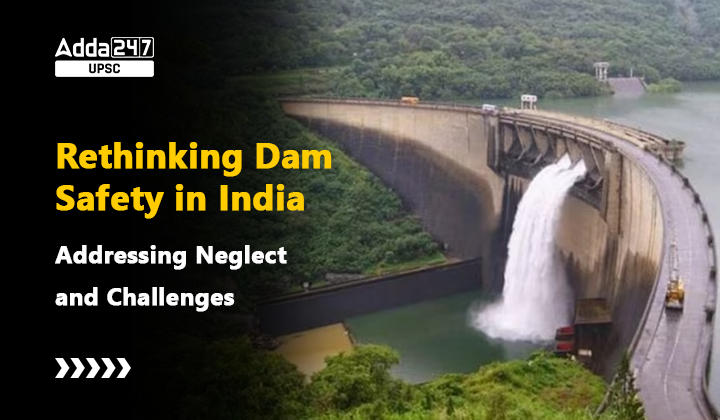Table of Contents
India is home to nearly 6,000 large dams, with a substantial percentage of them being over 25 years old and posing safety risks. The significance of dam safety cannot be overstated, especially in a country that has experienced a series of disastrous events related to dam failures. The Dam Safety Act (DSA) of 2021 was a crucial step towards addressing these concerns, but the recent events in Sikkim and Himachal Pradesh highlight the urgency of reevaluating and strengthening this legislation. This article delves into the provisions of the Dam Safety Act, the responsibilities it places on states, the implications of non-compliance, and the challenges faced in ensuring the safety of dams in India.
Dam Safety Act: A Response to Neglect
- The Dam Safety Act was introduced in December 2021 in response to the long-standing issues of inadequate surveillance and maintenance that have led to dam failure-related disasters.
- The Act sought to address these concerns by introducing key responsibilities and establishing national and state-level bodies for its implementation. Some of the fundamental provisions of the Dam Safety Act include:
National Committee on Dam Safety (NCDS): This committee is responsible for overseeing dam safety policies and regulations at the national level.
National Dam Safety Authority (NDSA): The NDSA is entrusted with the implementation of these policies and resolving disputes at the state level.
Chairman of the Central Water Commission (CWC): The head of the CWC is in charge of overseeing dam safety protocols at the national level.
State Committee on Dam Safety (SCDS) and State Dam Safety Organization (SDSO): At the state level, these bodies are established to ensure the implementation of dam safety measures.
Sikkim, for instance, established an SCDS with nine members, including experts in hydrology and dam design, highlighting the importance of local expertise in ensuring dam safety.
State Responsibilities and Reporting
States are obligated to fulfill various responsibilities under the Dam Safety Act. These include:
- Dam Classification: States must classify dams based on hazard risk, recognizing that the risk can fluctuate due to factors such as climate change, urbanization, and water usage patterns.
- Regular Inspections: Regular inspections of dams are a crucial requirement to ensure their structural integrity and safety.
- Emergency Action Plans: States must develop and maintain emergency action plans to mitigate the impact of potential dam failures.
- Flood Warning Systems: Implementing emergency flood warning systems is vital to provide early alerts and protect downstream communities.
- Safety Reviews and Periodic Risk Assessment Studies: Periodic reviews are necessary to assess the changing hazard risk and ensure the safety of dam structures.
Incident Reporting: For the first time, the Dam Safety Act mandates the reporting and recording of incidents related to dam failures.
- Previously, there was no statutory provision for systematic reporting, and no single agency was responsible for tracking such data. While the Central Water Commission (CWC) maintains records, the information is not consistently updated.
- Non-compliance with any provision of the Act is subject to penalties, including imprisonment and fines. If such non-compliance results in the loss of lives or imminent danger thereof, the responsible entity can be punishable with imprisonment for up to two years.
- This demonstrates the seriousness with which the government regards dam safety.
Challenges and Blind Spots
The recent Glacial Lake Outburst Flood (GLOF) in Sikkim, which led to the devastation of the Teesta III dam at Chungthang, reveals significant challenges and blind spots in both the Dam Safety Act and its implementation. Some of the critical issues include:
- Lack of Risk-Based Decision-Making: The DSA does not strongly promote risk-based decision-making, which is essential for identifying and addressing potential hazards. A robust dam safety framework should prioritize risk assessment and mitigation.
- Transparency Issues: Transparency is essential for ensuring public trust and accountability. However, India’s dam safety framework falls short in this aspect.
- Himanshu Thakkar, an environmental activist, emphasizes that all information related to dam safety should be promptly available to the public, but this is often not the case.
- The lack of transparency is further exacerbated by the fact that both national and state bodies comprise government employees and engineers involved in these projects, potentially compromising objectivity.
Poor Compliance at All Levels: The Sikkim GLOF incident exposes poor compliance at multiple levels, from dam design to spillway capacity.
Hazard profiling and regular assessments are mandated by the Act but are often not carried out as required.
Lack of Standardization: There is a lack of standardization in the analysis and reporting of dam failures. This inconsistency makes it difficult to assess and address issues effectively.
Recent Non-Compliance Cases
The Himachal Pradesh government’s notices to 21 hydroelectric projects for non-compliance with the DSA during the July-August floods demonstrate that the issues of non-compliance persist.
Conclusion
The Dam Safety Act of 2021 was a significant step towards addressing the neglected concerns related to dam safety in India. However, the recent disasters in Sikkim and Himachal Pradesh emphasize the need for continuous evaluation and improvement of the Act’s provisions and the implementation of dam safety measures.
Risk-based decision-making, transparency, standardized reporting, and rigorous compliance are key areas that require immediate attention. Dam safety is not just a matter of policy; it is a matter of public safety, environmental protection, and sustainable development.
India must prioritize these aspects to mitigate the risks associated with its vast network of dams and ensure the safety of its citizens and the environment.



 TSPSC Group 1 Question Paper 2024, Downl...
TSPSC Group 1 Question Paper 2024, Downl...
 TSPSC Group 1 Answer key 2024 Out, Downl...
TSPSC Group 1 Answer key 2024 Out, Downl...
 UPSC Prelims 2024 Question Paper, Downlo...
UPSC Prelims 2024 Question Paper, Downlo...




